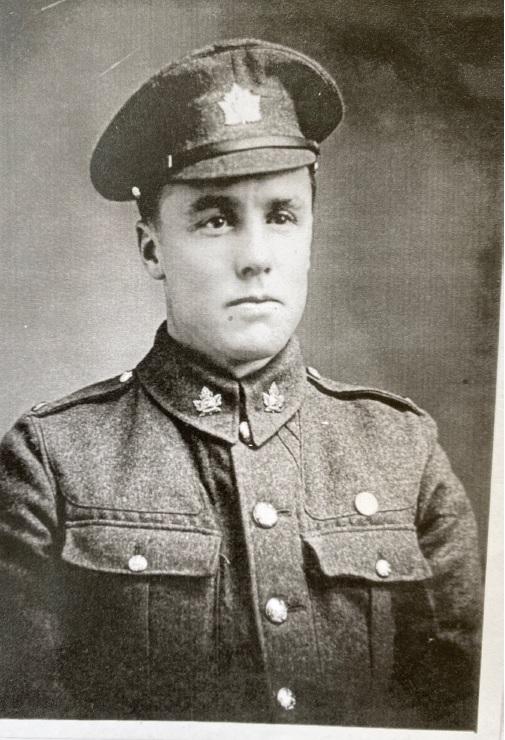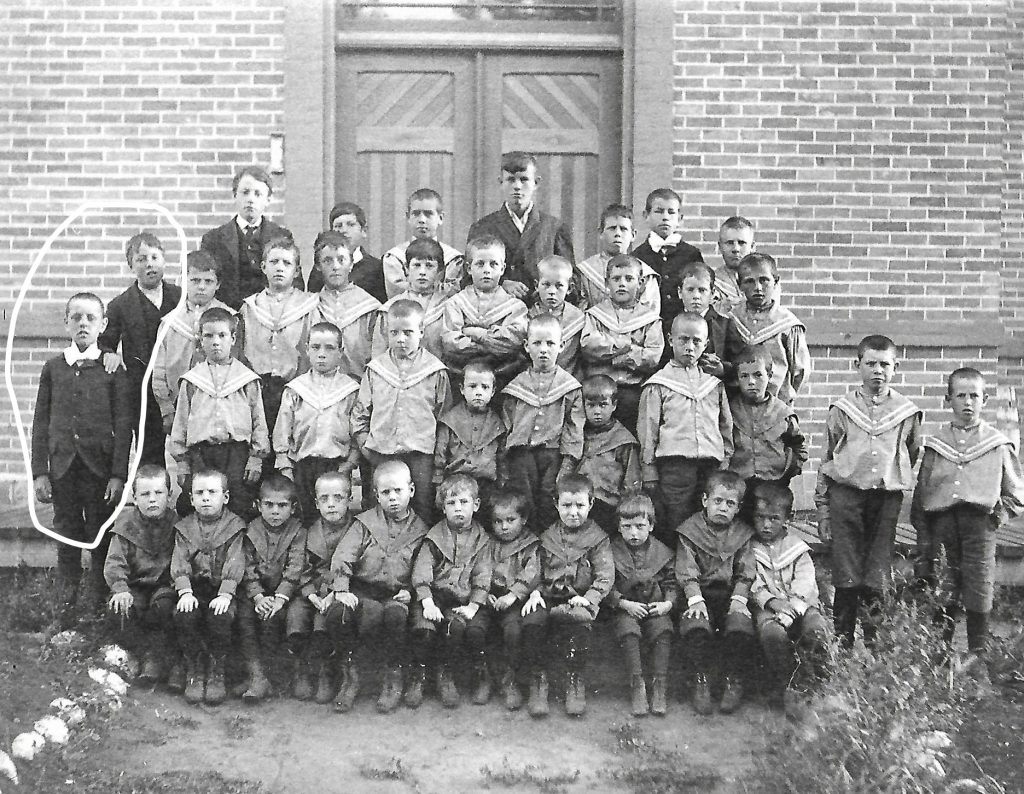
This is the thirteenth in a series of columns about the 70 British Home Children sent to St. Patrick’s Catholic Orphanage in Prince Albert between 1901 and 1907. While all orphanage records were destroyed in the terrible fire of 1947, every attempt has been made to trace the life stories of these dispossessed children through genealogy websites and newspaper databases
The Heffernan Twins: For King and Country
An estimated 10,000 young men who came to Canada as British Home Children enlisted in the Canadian military during the First World War. Many of them could not pass up the opportunity to reconnect with their homeland. “Once in the United Kingdom, they could then try to track down the families they had been forced to leave behind years before,” writes Veteran’s Affairs Canada on its website. “Some British Home Children also saw military service simply as a chance to escape cruel or abusive families in Canada. Many underage boys even ran away from their placements and lied about their age in order to sign up.”
Twin brothers John Joseph (Jack) Heffernan (1891-1952) and William Patrick (Bill) Heffernan (1891-1952), former British Home Children who had been sent to St. Patrick’s Catholic Orphanage in 1903, both enlisted in the Canadian Army in 1915 at age 24.
Jack and Bill were born in Woolwich, Kent, England on 11 October 1891 to Mary Ann Elizabeth (Ovens) Heffernan (1858-1926) and Daniel Mathias Heffernan (1858-1926). They had two older siblings, Daniel J. (1887-1963) Margaret Lillian (1889-1936) who was born deaf and dumb.
The twins’ parents separated in about 1894. Their father Daniel did not have the means to pay for a divorce from their mother. When he took a new mate, Martha Collins, in about 1906, they “pretended” to be married to avoid disgrace amongst neighbours.” [Source: Terence Heffernan, email to author, 11 October 2022.] Daniel and Martha went on to have six children in Woolwich.
I have not been able to find out anything about the lives of the twins in the 11 years between the time they were born and the date they were shipped to Canada as part of the British Home Child migration scheme. They were likely institutionalized. Jack and Bill sailed from Liverpool on 14 Oct 1903 aboard the Bavaria, sponsored by the Southwark Catholic Emigration Society. They arrived in Quebec City on 23 October, and from there they took the train to Prince Albert.
There is a photo of group of boys at St. Patrick’s Catholic Orphanage in the Prince Albert Diocesan Archives taken in 1904. I believe the Heffernan twins are on far left with one boy’s hand resting on his brother’s shoulder. They would have been about 12 at the time the photo was taken, thus they had grown out of the middy-style uniform worn by the younger boys. One of the boys’ heads is shaved, the other’s is not.

The Heffernan twins experienced some excitement on 7 February 1906 when a serious fire at the orphanage almost destroyed the new wing used as the quarters for about 30 boys. “All is gone, not even a blanket is left,” Brother E. M. Courbis wrote in an appeal for aid to the Irish Standard. “For the love of Almighty God help us again to refit the house as soon as possible.”
The 1906 Canada census for the Prairie Provinces shows Bill, age 15, still living at the orphanage, but I could not find Jack in that census. According to Jack’s son, Bruce Heffernan of Prince Albert, Jack found work at the Mossom Boyd ranch south of Prince Albert in the Clouston district. [Email to author dated 28 December 2017] Boyd bred horses, cattle, and sheep for show and sale in Canada, the United States, and Great Britain. Boyd is perhaps best known for mating buffalo and domestic cattle, resulting in what were known as “cattaloes”.
Bill Heffernan enlisted in the Canadian army in Edmonton, Alberta on 5 January 1915 at the age of 24. He served as a private in the 1st Canadian Overseas Railway Construction Corps (CORD). He listed his next of kin as his brother Daniel Heffernan in Woolwich, Kent, England. He gave his trade was land surveyor, perhaps for the Canadian Pacific Railway (CPR). Canadian railway units played a major role in the construction and maintenance of railways for the British Army in France and Belgium. CORD personnel were recruited by CPR throughout Canada.
Bill was granted permission to marry Mabel Rose Mickelburgh (1895-1954) at Plymouth, Devon, England on 13 December 1917. The couple returned to Canada in the summer of 1919 where Bill was discharged from the army on 6 July 1919 at the age of 28 after 44 months overseas. Mabel arrived on 1 August and they moved to 244 9th Street East in Prince Albert. The 1921 Canada census shows the couple living at that address with their infant daughter Barbara. Bill was working as a butcher in a city meat shop. By 1926, the Heffernans were living in Winnipeg. Bill died there on 20 November 1952, ten days before the death of his twin brother Jack.
On 19 June 1915, Jack enlisted in the Canadian Army at Prince Albert to fight overseas in the First World War; he was 24. Heffernan listed his next of kin as his mother, Mary Ann Heffernan, Littlehampton, England. He listed his trade as farmer.
Jack served with the 28th Battalion in France and on 15 September 1916 while fighting in the Battle of the Somme near Pozières he was hit by a piece of shrapnel in his right knee. The wound did not heal properly so he was invalided back to Canada. In 1917, Jack was a patient in a convalescent home in Regina, Saskatchewan where his leg was eventually amputated above his right knee.
After he was discharged from the army on 31 July 1917, Jack returned to Prince Albert where he secured work for a time with the Saskatchewan Provincial Police. Sometime after 1921, he married Lillian Beryl Logan, daughter of William R. Logan, former manager of the Mossom Boyd ranch where Jack had once worked. Jack and Lillian raised a family of six, four sons and two daughters while farming and operating a store and post office at Clouston. They retired to Prince Albert in 1949.
Bill Heffernan succumbed to cancer in Winnipeg on 17 November 1952. “Dad was with him at the last, and with his family till after the funeral,” Jack’s son William J. Heffernan wrote to his cousin in England. “On the day he came home to Prince Albert he had a heart attack and died within hours of his arrival home and a few days after his twin brother’s passing.” [Letter from William J. Heffernan, Saskatoon, to William J. Heffernan, Essex, England, 21 May 1991. Source Terence Heffernan.]
In addition to the Heffernan twins, at least 11 of the 70 British Home Children who came to the Prince Albert orphanage served overseas during World War 1; two of them died in the line of duty. Their names are:
• Charles Burtenshaw – wounded
• Hildreth Castling
• Joseph Daly
• Frederick Giblin
• Albert Green – wounded
• Henry Mahoney – wounded
• John Mahoney – wounded
• John McDonagh – killed in action
• Michael O’Brien
• John Pitt
• Lawrence White – killed in action
Of the 66,000 Canadians who lost their lives in the overseas conflict, over 1,100 were former British Home Children. [Source: Veteran’s Affairs Canada]

